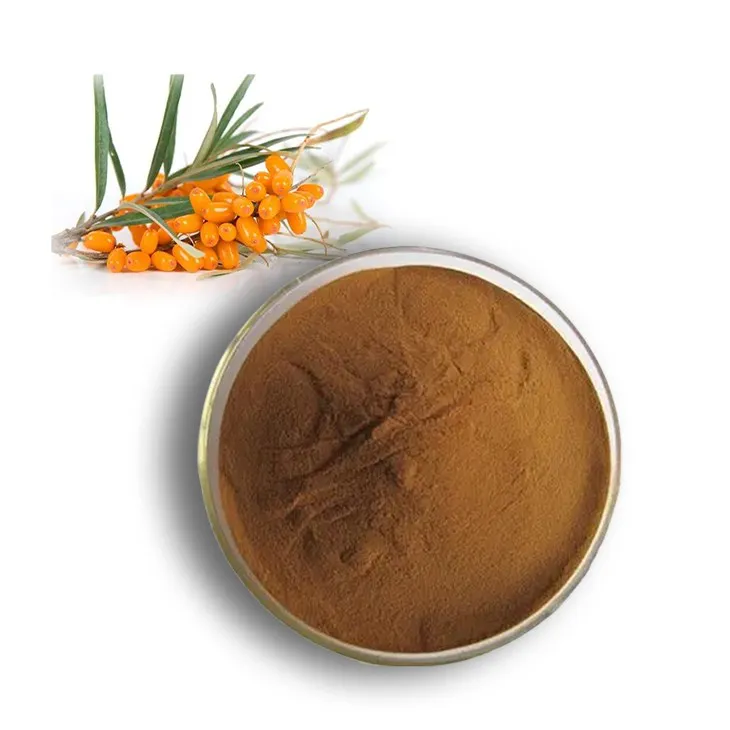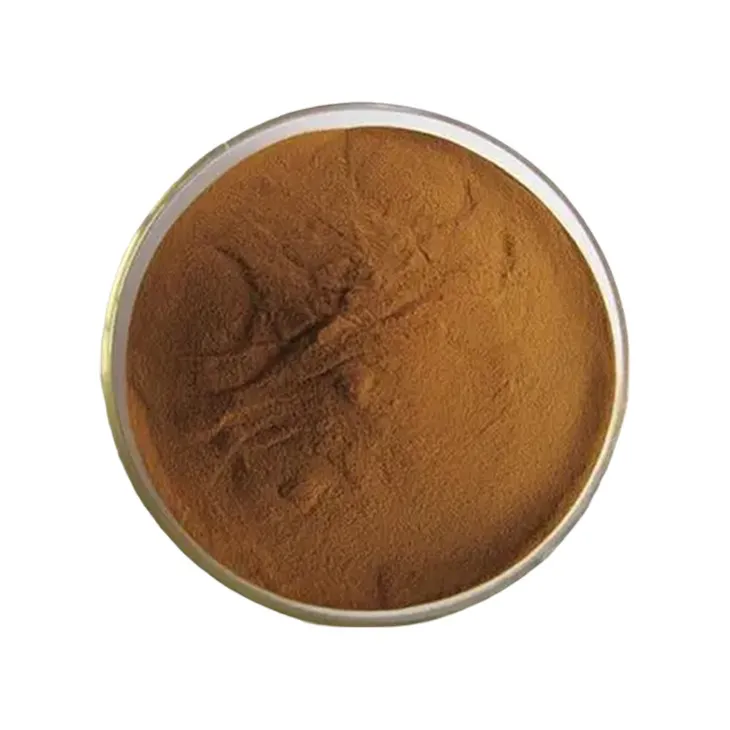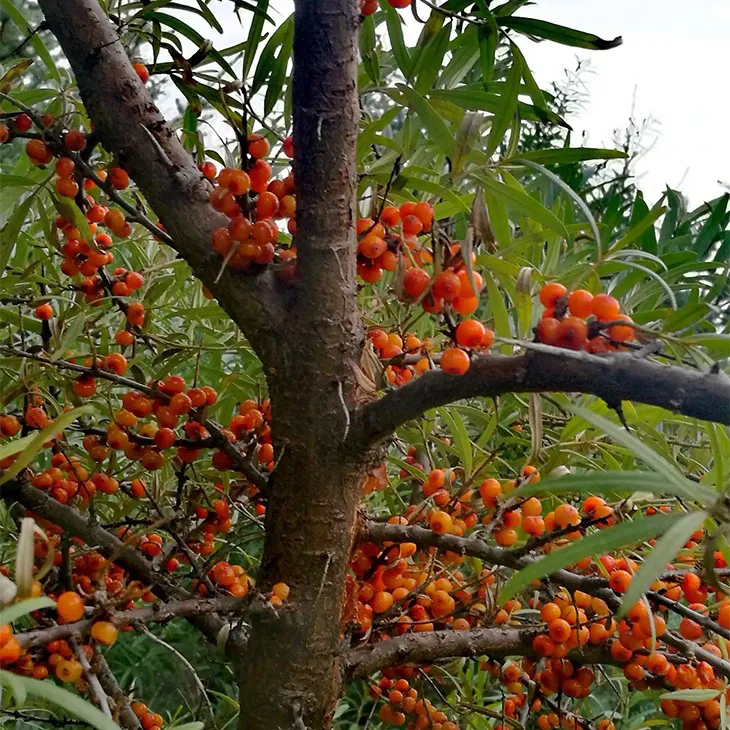- 0086-571-85302990
- sales@greenskybio.com
Benefits of Seabuckthorn Bark Extract in Cattle Feed.
2024-11-13

1. Introduction
The livestock industry, particularly cattle farming, is constantly seeking ways to improve animal health and productivity. One emerging area of interest is the use of natural additives in cattle feed. SeaBuckthorn bark extract has shown great potential in this regard. Seabuckthorn (Hippophae rhamnoides) is a plant that is rich in various bioactive compounds, and its bark extract can bring about multiple benefits when incorporated into cattle feed.

2. Impact on Rumen Microbiota
2.1 Modulation of Microbial Population
The rumen is a complex ecosystem within the cattle's digestive system, housing a diverse range of microorganisms. These microorganisms play a crucial role in the digestion of feed. SeaBuckthorn bark extract can modulate the microbial population in the rumen in several ways.
- It can promote the growth of beneficial bacteria. For example, certain species of fibrolytic bacteria that are responsible for breaking down fibrous components of the feed can thrive in the presence of seaBuckthorn bark extract. This is important as it allows for more efficient utilization of the roughage in the feed. - At the same time, it may inhibit the growth of harmful microorganisms. Some pathogenic bacteria or those that produce toxins may be suppressed by the bioactive compounds present in the seabuckthorn bark extract. This helps in maintaining a healthy rumen environment.
2.2 Enhancement of Fermentation Efficiency
As a result of the modulation of the rumen microbiota, there is an improvement in the fermentation efficiency of feed.
- The enhanced microbial activity leads to better breakdown of complex carbohydrates in the feed. Carbohydrates such as cellulose and hemicellulose, which are otherwise difficult to digest, are more effectively fermented. This results in increased production of volatile fatty acids (VFAs), which are an important energy source for cattle. - Moreover, the improved fermentation also means that there is less waste of nutrients in the form of undigested feed. The overall nutrient availability from the feed is enhanced, which can contribute to better growth and productivity of the cattle.

3. Nutritional Contribution
Seabuckthorn bark extract contains a variety of nutrients and phytochemicals that can have a positive impact on the health of cattle.
3.1 Vitamins and Minerals
- It may be a source of certain vitamins. For example, seabuckthorn is known to contain vitamin C, which although not typically a major requirement in cattle as they can synthesize it themselves, can still play a role in times of stress or in enhancing the immune system. - In terms of minerals, it could potentially supply trace elements that are essential for various physiological functions in cattle. These may include elements like zinc, which is involved in wound healing and immune function, and manganese, which is important for bone development and enzyme activation.
3.2 Phytochemicals
- The extract is rich in phytochemicals such as flavonoids. Flavonoids have antioxidant properties. In cattle, these antioxidants can help protect cells from oxidative damage. Oxidative stress can occur due to various factors such as exposure to environmental pollutants or during periods of high metabolic activity. By reducing oxidative stress, the overall health and well - being of the cattle are maintained. - Other phytochemicals may have bioactive functions that are yet to be fully explored. For example, some may interact with the animal's hormonal system or have a role in gene expression, which could potentially influence growth, reproduction, and other physiological processes.

4. Anti - Inflammatory Effects
One of the significant benefits of seabuckthorn bark extract in cattle feed is its anti - inflammatory effects.
- Inflammation in cattle can be caused by various factors, including infections, injuries, or poor diet. Inflammatory processes can lead to reduced performance, decreased appetite, and general discomfort in the animals. The bioactive compounds in seabuckthorn bark extract can help to mitigate these inflammatory responses. - By reducing inflammation, the cattle are more likely to have a normal appetite. This is crucial as proper nutrition is essential for growth, milk production (in dairy cattle), and overall productivity. - Additionally, reduced inflammation can also lead to faster recovery from any existing health issues. For example, if a cow has an injury or an infection, the anti - inflammatory properties of the seabuckthorn bark extract can aid in the healing process and reduce the associated pain and discomfort.

5. Implications for Cattle Farming Industry
The use of seabuckthorn bark extract in cattle feed has several important implications for the cattle farming industry.
5.1 Improved Animal Health
- Overall, the multiple benefits of seabuckthorn bark extract contribute to better animal health. Healthier animals are less likely to succumb to diseases, which reduces the need for veterinary interventions and the use of antibiotics. This is not only beneficial for the individual animals but also for the industry as a whole in terms of reducing production costs and meeting consumer demands for antibiotic - free products. - Improved health also means that the animals have a longer productive lifespan. For example, dairy cows can continue to produce milk at a consistent level for a longer period, and beef cattle can reach their optimal slaughter weight more efficiently.
5.2 Enhanced Productivity
- The enhanced nutrient availability from the feed, as a result of improved rumen fermentation and the nutritional contribution of the seabuckthorn bark extract, leads to better growth rates in cattle. This is especially important in the beef cattle industry where faster growth means shorter production cycles and increased profitability. - In dairy cattle, improved health and nutrition can lead to increased milk production both in terms of quantity and quality. The milk may have a better composition, with higher levels of beneficial components such as proteins and fats.
5.3 Sustainability
- Seabuckthorn is a plant that can be grown in a variety of environments, including marginal lands. Its cultivation for the extraction of bark extract can be part of a sustainable agricultural system. This can provide an additional source of income for farmers while also contributing to environmental conservation. - By improving the efficiency of cattle production through the use of seabuckthorn bark extract, there is also a more sustainable use of resources. Less feed is wasted, and the environmental impact of cattle farming, such as methane emissions from inefficient digestion, can be reduced.
6. Conclusion
In conclusion, seabuckthorn bark extract has numerous benefits when used in cattle feed. Its impact on the rumen microbiota, nutritional contribution, and anti - inflammatory effects all contribute to improved animal health and productivity. For the cattle farming industry, this represents an opportunity to enhance production in a more sustainable and efficient manner. However, further research is still needed to fully understand the mechanisms of action of seabuckthorn bark extract and to optimize its use in cattle feed.
FAQ:
1. How does seabuckthorn bark extract modulate the rumen microbiota?
Seabuckthorn bark extract can change the composition and function of the rumen microbiota. It may provide substrates or signals that promote the growth of beneficial bacteria while inhibiting the growth of harmful ones. However, the exact mechanisms are still under investigation. Some components in the extract might interact with the microbial cells directly or indirectly through changing the rumen environment, such as pH or nutrient availability, to achieve the modulation of the microbial population.
2. What are the specific nutrients in seabuckthorn bark extract for cattle?
Seabuckthorn bark extract contains various nutrients. It may include vitamins such as vitamin C and some B - vitamins. Minerals like potassium and magnesium may also be present. Additionally, it contains organic acids and amino acids which are essential for cattle's physiological functions. These nutrients can supplement the diet of cattle and contribute to their growth, development, and overall health.
3. How can the anti - inflammatory effects of seabuckthorn bark extract be measured in cattle?
There are several ways to measure the anti - inflammatory effects. One common method is to monitor the levels of inflammatory markers in the blood, such as cytokines (e.g., interleukin - 6). Another approach is to observe the physical symptoms of inflammation in the animals, such as swelling, redness, or heat in certain body parts. Also, changes in the expression of genes related to inflammation in the cattle's tissues can be analyzed through techniques like real - time polymerase chain reaction (RT - PCR).
4. Can seabuckthorn bark extract replace other additives in cattle feed?
While seabuckthorn bark extract has multiple benefits, it may not completely replace all other additives in cattle feed. It depends on the specific requirements of the cattle and the overall composition of the feed. For example, if the feed is lacking in certain essential nutrients that are not provided in sufficient amounts by the seabuckthorn bark extract, other additives may still be necessary. However, in some cases where the aim is to improve rumen function or reduce inflammation, it can be a valuable addition to the feed.
5. How much seabuckthorn bark extract should be added to cattle feed?
The appropriate amount of seabuckthorn bark extract to be added to cattle feed depends on various factors, including the age, weight, and health status of the cattle, as well as the composition of the existing feed. Generally, it is recommended to start with a small amount and gradually increase it while closely monitoring the cattle's response. Preliminary studies suggest that a range of 1 - 5% of the total feed weight might be a starting point for further exploration, but more research is needed to determine the optimal dosage.
Related literature
- The Role of Seabuckthorn in Animal Nutrition"
- "Beneficial Effects of Phytochemicals from Seabuckthorn in Livestock"
- "Seabuckthorn Extracts and Their Impact on Rumen Function in Ruminants"
- ▶ Hesperidin
- ▶ Citrus Bioflavonoids
- ▶ Plant Extract
- ▶ lycopene
- ▶ Diosmin
- ▶ Grape seed extract
- ▶ Sea buckthorn Juice Powder
- ▶ Fruit Juice Powder
- ▶ Hops Extract
- ▶ Artichoke Extract
- ▶ Mushroom extract
- ▶ Astaxanthin
- ▶ Green Tea Extract
- ▶ Curcumin
- ▶ Horse Chestnut Extract
- ▶ Other Product
- ▶ Boswellia Serrata Extract
- ▶ Resveratrol
- ▶ Marigold Extract
- ▶ Grape Leaf Extract
- ▶ New Product
- ▶ Aminolevulinic acid
- ▶ Cranberry Extract
- ▶ Red Yeast Rice
- ▶ Red Wine Extract
-
Sophora Flavescens Root Extract
2024-11-13
-
Beetroot juice Powder
2024-11-13
-
Shikonin
2024-11-13
-
Milk Thistle Extract
2024-11-13
-
Grape Seed Extract
2024-11-13
-
Peppermint Extract Powder
2024-11-13
-
Maitake Mushroom Extract
2024-11-13
-
Polygonum multiflorum extract
2024-11-13
-
Ivy Extract
2024-11-13
-
Purple Sweet Potato Extract
2024-11-13





















